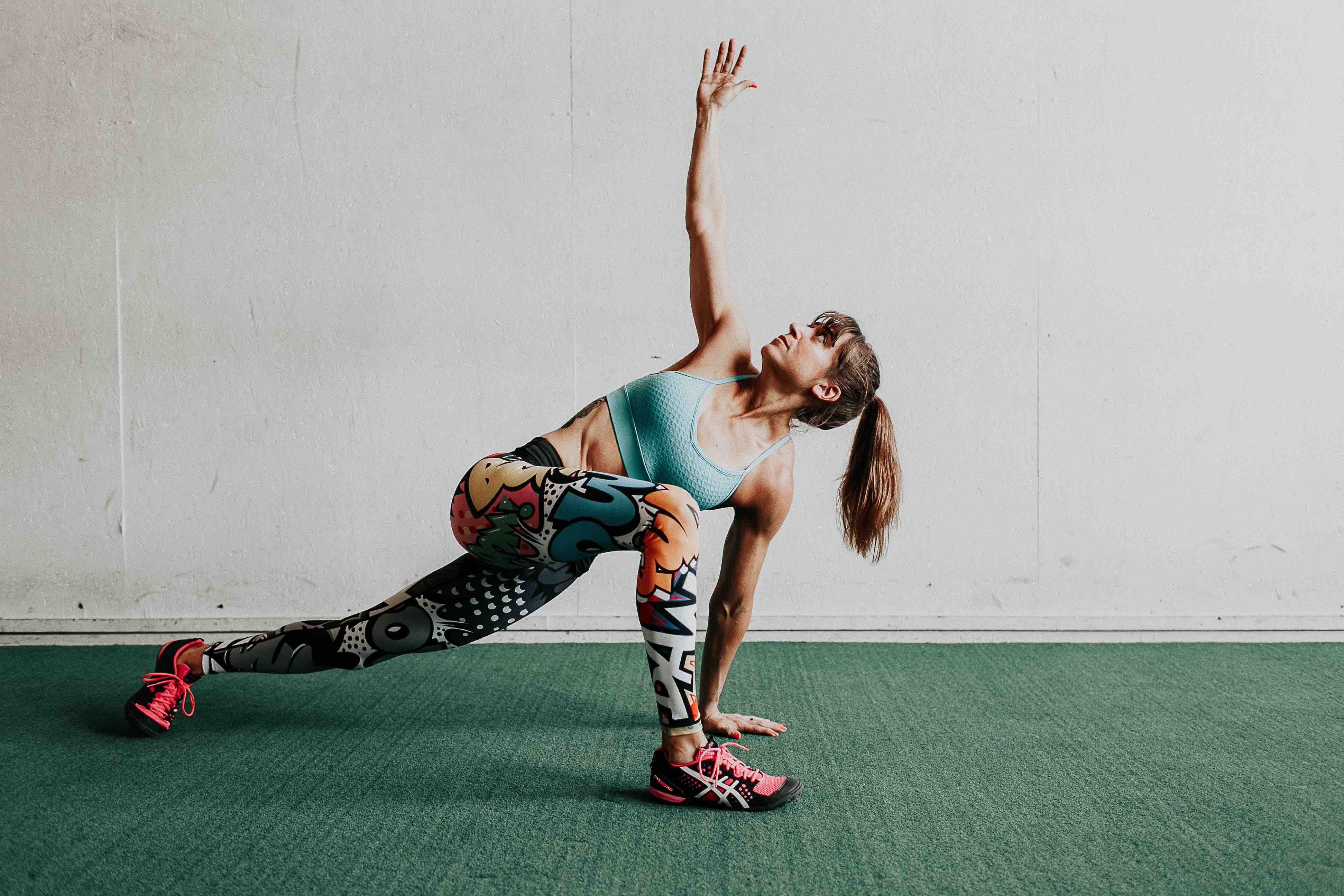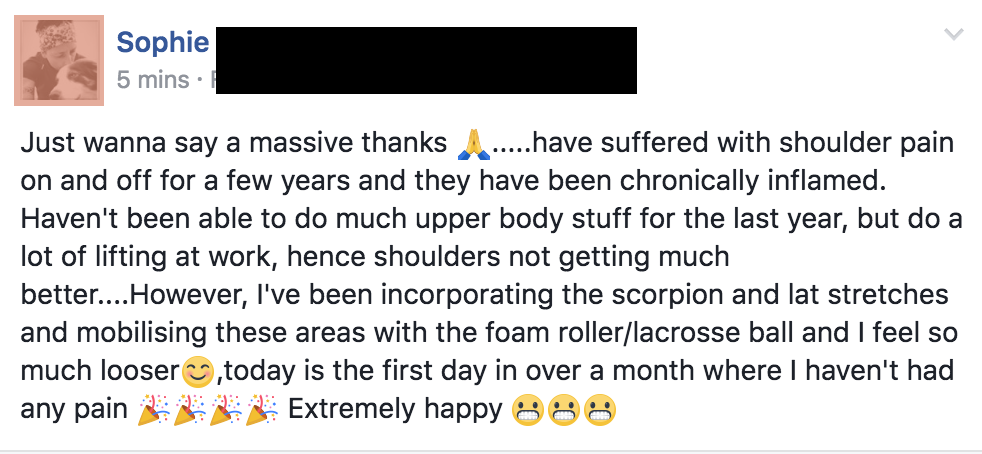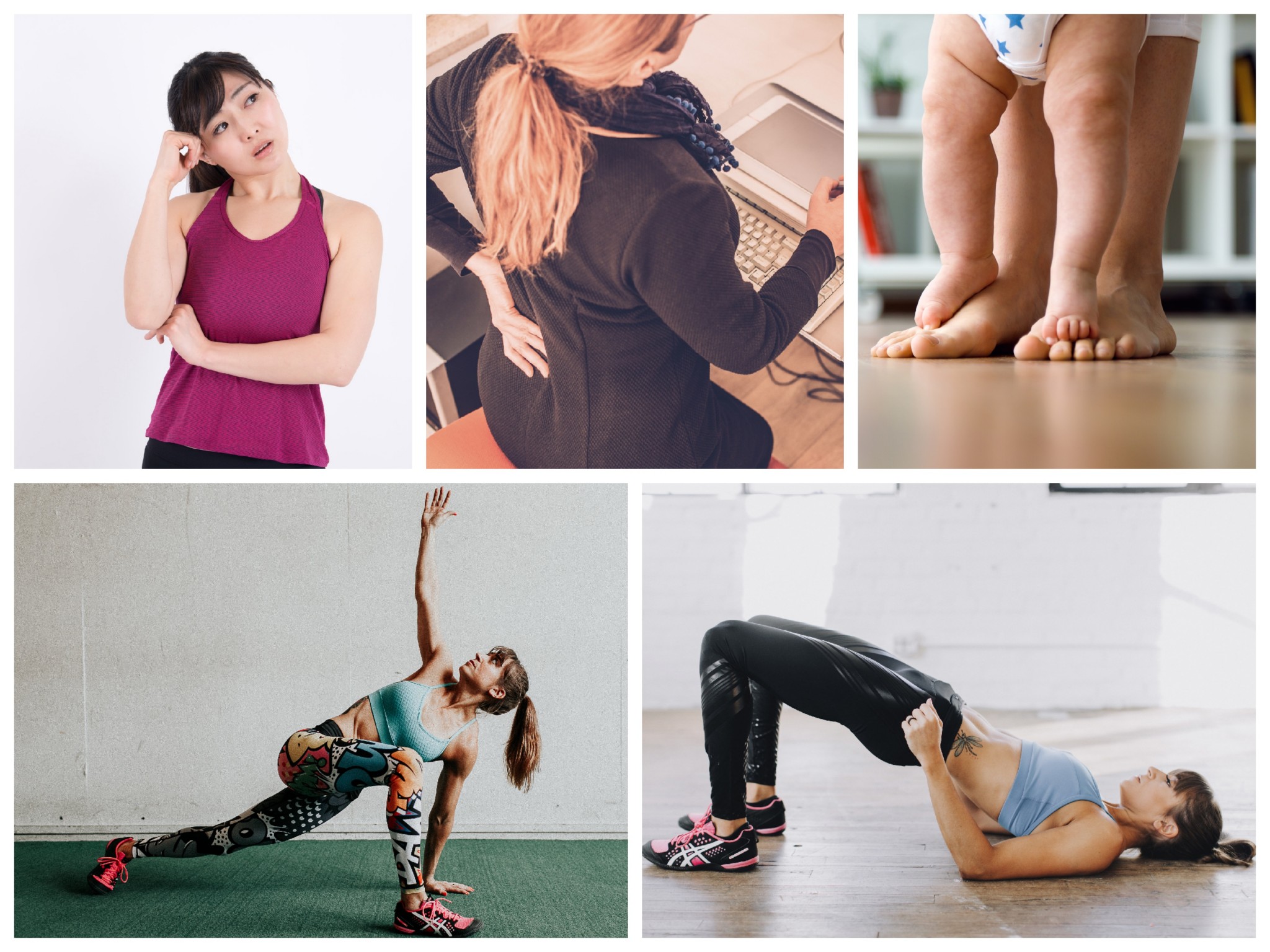
by Cori Lefkowith | May 4, 2018 | Blog, Pain Relief
When you are in pain, what do you do?
Do you…
A. Avoid any sort of exercise. I mean you need to “rest” it, right?
B. Power through. No pain no gain!
C. Randomly and sporadically throw in some “rehab” and simply avoid the moves that cause pain.
D. Just figure you can never do certain moves again.
E. Slowly start implementing rehab exercises to improve your mobility and correct the imbalances and compensations that may have led to your pain? Do you start a search and destroy mission to locate and identify other imbalances NOT at the source of pain that may be the issue?
Of course you do E, right!?!
Unfortunately most of us DON’T do E. unless we’ve been there before.
But E is what helps us not only start to alleviate aches and pains but PREVENT THEM FROM RETURNING.
And sometimes by working through just even 10 minutes of the foam rolling, stretching and activation for a WEEK, we can start to restore proper mobility and begin to correct the imbalances.
Heck, it can even relax our central nervous system so we start to feel a whole heck of a lot better even as our our body becomes more mobile, stable and balanced.
E. doesn’t mean crazy amounts of time on recovery work. It can even be implemented while you FEEL GOOD just as part of your warm up to your current workouts (or as an excuse to move a little extra during the day).
Now now…I’m not telling you not to get checked out or not to listen to your doctor. I’m just telling you that too often we AVOID when we can CORRECT. We rest when we can REHAB.
Even if you do take time off, which may help start the healing process, it doesn’t prevent the injury from reoccurring. You NEED to correct the underlying problems. Even if you do have to first have surgery, it means restoring proper mobility and stability post surgery to prevent the trauma, aka surgery from causing compensations again!
It’s why I created the RStoration program. And it’s why I also just feel so honored to get to see comments like this….



There is no time like the present. Just start spending 10 minutes a day for even just 7 days on that boring PREHAB stuff and you can get to moving and feeling better.
10 minutes a day is a whole heck of a lot better than being sidelined with injury!
Are you foam rolling, stretching and activating daily?
Are you working to correct the underlying problems instead of just avoid exercises forever?
Or are you constantly cycling through injury, pushing through the pain and then having to take long periods off?
Continue reading about the 3-Part RStoration Method of SMR + Stretching + Activation For Injury Prevention.
–> The 3-Part RStoration Method

by Cori Lefkowith | Jun 10, 2017 | Blog, Foam Rolling, Functional Fitness, Pain Relief
All too often we go to the gym with the intention of just getting our workout DONE.
We lift the weights and do the movements and try to push ourselves to work hard.

But when was the last time you asked yourself, “Where do I feel this? Are the right muscles ACTUALLY working?”
The sad part is…Most of us haven’t thought about that in awhile. We don’t really think about WHERE we feel a move or what muscles are working.
Because most of what we see promoted in fitness is how much you can lift or what crazy moves you can do…or even how fast you can finish a workout.
It is all about doing something GNARLIER…something better or more advanced.
It’s about pushing harder, doing MORE.
But guess what the often unknown side effect of that push harder, do more culture is?
INJURY!
And it is all because our proprioception SUCKS.
Now I’m not telling you not to work hard in the gym. To not go lift weights. To not have fun taking on crazy new hard challenges.
But what I am telling you is, you also need to include proprioception work in your training.
So what the heck is proprioception?
Well simply put proprioception is our body awareness. Our ability for our mind and body to communicate and understand where our body is in space.
It is our mind’s ability to recruit the muscles of our body to act.
Sounds like something you should be able to do naturally, right?
I mean, if you can squat, your mind and body are communicating properly, right?
So you think this maybe doesn’t relate to you because you can run and squat and deadlift…
WRONG!
We’ve heard sitting is bad for us – that it creates poor posture.
 But what we don’t realize is that all of that sitting at a computer, sitting watching TV, hunching over our phones texting or even driving in the car not only leads to poor posture, but also imbalances that kill our proprioception.
But what we don’t realize is that all of that sitting at a computer, sitting watching TV, hunching over our phones texting or even driving in the car not only leads to poor posture, but also imbalances that kill our proprioception.
All of that forward flexion (aka rounding forward as we sit with our heads forward) causes our mind to want to use the WRONG MUSCLES to perform movements.
So yes, your mind will connect with your body and recruit muscles to perform a squat.
Heck, if you are athletic, it may even recruit muscles so you perform a seemingly PERFECT looking squat.
The problem is YOUR MIND IS CONNECTING WITH THE WRONG MUSCLES. It is recruiting muscles that can’t handle the load to perform a movement!
It is compensating.
Our bodies take the path of least resistance to perform the movements we ask of it.
It is a wonderful and horrible thing. Our mind wants to do what we ask so it recruits the muscles available. Muscles that may be overactive because of our daily posture.
Muscles that aren’t necessarily the best option for the job.
But because those are the only ones your brain can easily recruit, it calls on them. And then you are able to run and squat and do the movements your workouts and daily life require….
However, we can only ask so much of these muscles. And the loads we ask them to carry because we can’t recruit the right muscles is too much for them.
And that is why we end up injured.
The injury may happen when you are doing something seemingly innocent and easy.
Heck, it could happen when bending over to reach for a pencil on the ground.
We’ve all had friends do that…or maybe it has happened to us even. We “sleep wrong.” Or we just turn to look or reach or bend for something and WHAM! pain and injury.
But it wasn’t really that event that injured you. No…that was just the “straw that broke the camels back.”
That final thread just finally snapped.
But it was really a build up of things that caused it. A build up that started because we lacked proper proprioception.
Because we didn’t have that mind-body connection to begin with.
So…long story short…Proprioception is the mind-body connection.
And hopefully now you’re starting to see that being able to squat or run doesn’t necessarily mean you have great proprioception or even any mind-body awareness for that matter.
Repeating a movement doesn’t mean the right muscles are working.
Ever wonder why you squat but your glutes never change? All you feel is your quads working?
Or ever wonder why people will say their back is sore after rows or pull ups but all you feel is your arms or maybe even your neck and shoulders?
That right there is the sign that you aren’t recruiting the right muscles for the job.
But that requires you to start THINKING about the muscles that are working WHILE you workout.
You can’t simply try to “get through” your workout. You can’t simply try to go fast or lift more.
NOPE!
You’ve got to actually THINK about the muscles that should be working.
That is the first step to not only realize that the right muscles AREN’T working, but also the first step toward getting the right muscles activated.
It is the first step in restoring proper proprioception!
That is why I asked, “But when was the last time you asked yourself, “Where do I feel this? Are the right muscles ACTUALLY working?'”
Because you’ve got to start thinking about what muscles are working when you move. If you think about recruiting the right muscles, you can start to rebuild that connection.
But it can be difficult to start doing that during compound lifts such as the squat or deadlift or even when you run when the muscles are inactive.
You may NOT feel them working. And you may not be able to focus on them working without risking your form breaking down or further compensations.
So to get yourself to be able to start thinking about what muscles are working, you need to include activation exercises in your routine.
You need to return to basics.
It’s kind of like how children learn to walk and then run. They don’t just jump right into running, right?
 First they crawl. Then they stand while holding on. Then they stand on their own. Then they stand, but hold on to start walking. Then finally walking a few steps on their own…Until they are able to not only walk, but run.
First they crawl. Then they stand while holding on. Then they stand on their own. Then they stand, but hold on to start walking. Then finally walking a few steps on their own…Until they are able to not only walk, but run.
They had to build that mind-body connection slowly, starting with the basics.
You’ve got to do the same.
It sucks to regress movements…I know…trust me.
But if you want to keep yourself healthy and even lift more and run faster, no matter how advanced you are, you’ve got to return to the basics.
Basic, bodyweight exercises that ISOLATE the muscles you want to get working correctly. Muscles that on their own don’t want to work because of our daily lifestyle.
These aren’t moves you are going to try to load down with tons of weight. These are moves that help you focus on the muscles that should be working so you can get them engaged BEFORE you go do more compound lifts.
By doing these moves, you can help yourself KNOW the muscles are turned on because they may even be “burning” before you go do your workout.
You feel them engage through the isolation of them so you can then more easily think of them working during your lift.
For example, you are going to run or even go deadlift.
And you want to get your glutes activated because you now realize they are inactive and have been causing you some low back and even hip pain.
You struggle to think about them engaging and never feel them during your runs or lifts.
So you decide to try using some activation moves before you workout.
 You do bodyweight glute bridges, focusing on extending your hips and squeezing your glutes. You engage your abs and make sure your low back and hamstrings don’t take over. You start to FEEL the contraction of your glutes and they start to burn.
You do bodyweight glute bridges, focusing on extending your hips and squeezing your glutes. You engage your abs and make sure your low back and hamstrings don’t take over. You start to FEEL the contraction of your glutes and they start to burn.
You then add in some fire hydrants and a few other basic moves. Your really feel those glutes “burning” by the end. Not tired. Just really AWAKE.
You go right into your lift and run ALREADY feeling your glutes.
And guess what? When you think about the muscle during your workout, you actually KNOW you are using it because there was already a pump going.
That burn beforehand makes it easier to be aware of what is working.
You are able to make your glutes work because of the basic activation moves that got them engaged. Your brain has established a connection with your glutes before you do more compound moves where it has to recruit more muscles at the same time.
You started restoring your mind-body connection. You started developing proper proprioception!
Exciting, right?!
I mean the right muscles working so you can run faster, lift more and avoid injury!?! HECK YES!
Now while it would be nice if it only took one activation session and BAM! results, it often doesn’t work that way.
I do activation as part of every warm up and have my clients do the same. Especially on days when we are working muscles, like the back and butt, that often don’t want to engage naturally.
And, as you start to turn muscles on, you may need to regress other movements in your workouts so that you don’t cause those newly activated muscles to shut off.
Loading down movements with too much weight or doing a super high volume when you are just learning to get muscles activated may lead you to keep compensating.
If you’ve been doing pull ups with neck pain and decide to start working to activate your back with activation exercises (and maybe even get it working with those moves), but then jump right back in with weighted pull ups or even a super high volume of repetitions, you may still end up with neck pain.
Because you are still overloading a muscle that your brain is still just beginning to learn how to recruit.
And at the first sign of too much stress, guess what?!
Your body reverts back to the easiest to recruit muscles. Your body reverts back to the path of least resistance aka what it knows best!
And you’ll still end up with aches and pains.
So what does this all mean?
It means you’ve got to regress to progress and put ego aside.
It freaking sucks. I know. None of us want to go “backward.”
But it isn’t going backward.
It’s taking one step back…Ok maybe like 10 steps back…But we are taking those steps back to end up 20 steps ahead of where we were!
So stop allowing aches and pains and injuries to hinder your workouts. Stop letting the desire to do MORE or be gnarly(…aka our ego…yes we all have it…I know I do!) hold us back from ACTUALLy lifting more or running faster in the long run.
Regress to progress.
Start being conscious of your body during your workouts and stop just powering through. Especially powering through the pain.
Ask yourself, “Where do I feel this? What muscles are working?” and start rebuilding your mind-body connection. Restore proper proprioception and start moving and feeling better TODAY.
And if you need some help, you’ll want to start with a 3 part process – Foam Rolling (Self Myofascial Release), Stretching AND Activation. This is what I call the RStoration Method.
 You are relaxing those muscles that want to try to engage and carry a load they can’t. So you are relaxing them so your brain doesn’t want to recruit them. And then you are getting the right muscles for the job engaged and working.
You are relaxing those muscles that want to try to engage and carry a load they can’t. So you are relaxing them so your brain doesn’t want to recruit them. And then you are getting the right muscles for the job engaged and working.
Through that three part process, you can eliminate pain for GOOD and get more out of your workouts.
Here are some great articles to help you get started covering each of the three part in the RStoration Method!
Self Myofascial Release aka Foam Rolling:
Stretching:
Activation:









 But what we don’t realize is that all of that sitting at a computer, sitting watching TV, hunching over our phones texting or even driving in the car not only leads to poor posture, but also imbalances that kill our proprioception.
But what we don’t realize is that all of that sitting at a computer, sitting watching TV, hunching over our phones texting or even driving in the car not only leads to poor posture, but also imbalances that kill our proprioception. First they crawl. Then they stand while holding on. Then they stand on their own. Then they stand, but hold on to start walking. Then finally walking a few steps on their own…Until they are able to not only walk, but run.
First they crawl. Then they stand while holding on. Then they stand on their own. Then they stand, but hold on to start walking. Then finally walking a few steps on their own…Until they are able to not only walk, but run. You do bodyweight glute bridges, focusing on extending your hips and squeezing your glutes. You engage your abs and make sure your low back and hamstrings don’t take over. You start to FEEL the contraction of your glutes and they start to burn.
You do bodyweight glute bridges, focusing on extending your hips and squeezing your glutes. You engage your abs and make sure your low back and hamstrings don’t take over. You start to FEEL the contraction of your glutes and they start to burn. You are relaxing those muscles that want to try to engage and carry a load they can’t. So you are relaxing them so your brain doesn’t want to recruit them. And then you are getting the right muscles for the job engaged and working.
You are relaxing those muscles that want to try to engage and carry a load they can’t. So you are relaxing them so your brain doesn’t want to recruit them. And then you are getting the right muscles for the job engaged and working.
